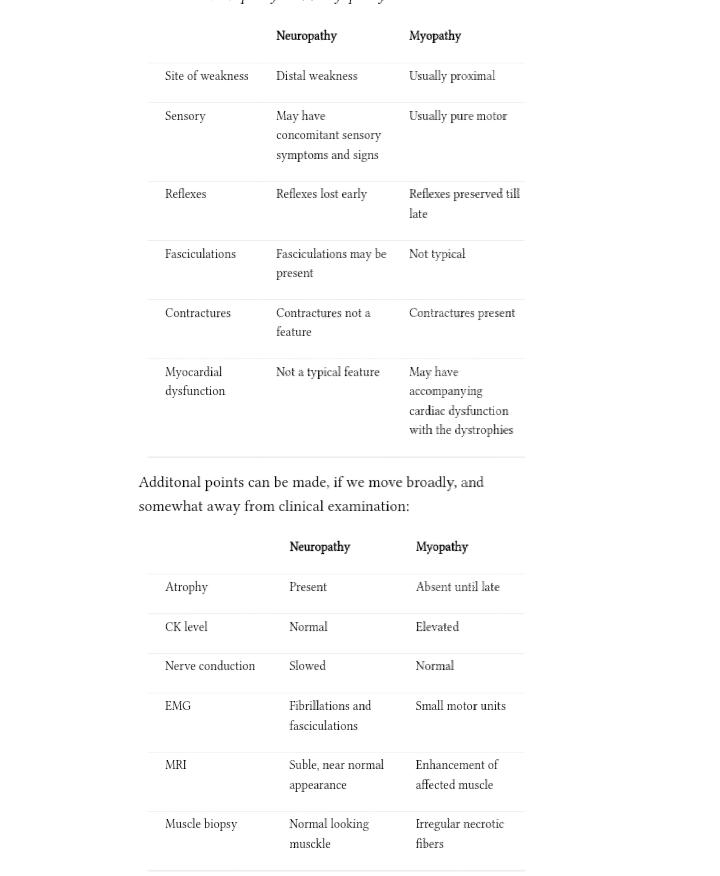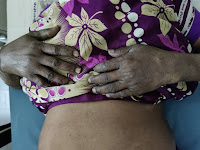- I have been given this case to solve in an attempt to understand the topic of "patient clinical data analysis" to develop my competency in reading and comprehending clinical data including history, clinical findings, investigations and come up with a diagnosis and treatment plan.
You can find the entire real patient clinical problem in this link here made by our interns
https://hitesh116.blogspot.com/2020/05/12may-2020-elog-medicine-intern.html?m=1
After analysing the history, chief compliants, and investigations of the patient, my review about the case is as follows.
The patient had
1. Weakness in both LL since 20 days , which actually started 2 yrs back in the proximal limbs, which was insidious in onset, gradually progressed to b/l distal regions.
•H/o difficulty in squatting and getting up from that position, difficulty in wearing and holding chappals
2. BILATERAL non pitting type of edema
Past history :
No similar complaints in the past i.e. 2yrs back.
No h/o DM, HTN, CVD,EPILEPSY, TB,cerebro vascular diseases.
No significant family history.
Personal history:
Appetite:normal, sleep: adequate, b&b movements :regular, no addictions.
On examination, reflexes are absent in both LL,Power reduced to 4-/5.
Investigations:
Hemogram revealed leukocytosis (lymphocytosis)
RFT: Urea, creatinine, uric acid, phosphorus are slightly elevated, chlorine decreased.
CUE: albumin and 3 -5 pus cells are present.
Histopathology: chronic inflammatory cells in between muscle fibres are seen, connective tissue composed of adipocytes and blood vessels, evidence of atrophy and necrosis of muscle fibre is found.
Diagnosis:
https://derangedphysiology.com/main/required-reading/neurology-and-neurosurgery/Chapter%205.5.2/features-distinguish-myopathy-neuropathy
Proximal weakness, no sensory impairment, and presence of necrotic fibres in muscle biopsy , are indicative towards myopathy than neuropathy.
Dd: it could be an inflammatory myopathy, due to increased lymphocytic count, and other symptoms, but muscle biopsy doesn't show any chronic inflammatory cells, so polymyositis is ruled out.
https://www.ninds.nih.gov/disorders/all-disorders/inflammatory-myopathies-information-page
2. It could be Beckers muscular dystrophy,
• progressive muscle weakness
• necrotic muscle fibres
• male predisposition
• usually starts from childhood to early 20s.
All this above factors are suggestive of Beckers muscular dystrophy from the given data.
But to diagnose it, we may need more information like
1.CREATININE KINASE LEVELS
2.CPK
3. Application of Gowers manouevre by the patient while getting up.
4. Pseudo hypertrophy of calf muscles in patient.
And whether mother has muscle cramps and muscle weakness and Cardio myopathy as it is a X linked recessive disorder.
ADVICE
I would recommend the following tests to be done
1.Creatinine kinase
2.CPK
3.Genetic testing
There is not a cure for Becker muscular dystrophy at present. A doctor may prescribe steroid medications to help individuals remain able to walk for as long as possible.
The clinical course of Becker muscular dystrophy is variable. Some people may require a wheelchair by the time they reach their 30s; others may be able to continue walking with or without a cane for many years.
A multidisciplinary team of specialists with experience in treating Becker muscular dystrophy can help address symptoms:
Physical and occupational rehabilitation professionals can design exercise programs and teach stretching activities to minimize contractures, which are hardened or deformed joints caused by contracting muscles and tendons.
Orthopaedic surgeons with expertise in muscular dystrophy can treat contractures and scoliosis.
Cardiologists track the patient’s heart function with EKGs and echocardiograms.
References:
1.https://hitesh116.blogspot.com/2020/05/12may-2020-elog-medicine-intern.html?m=1
2.https://derangedphysiology.com/main/required-reading/neurology-and-neurosurgery/Chapter%205.5.2/features-distinguish-myopathy-neuropathy
3.https://www.ninds.nih.gov/disorders/all-disorders/inflammatory-myopathies-information-page
4.https://rarediseases.info.nih.gov/diseases/5900/becker-muscular-dystrophy.
Here by i conclude.



